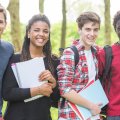When we teach social responsibility in the classroom, what do we hope to achieve? Do we want our students to simply understand the concept, or is there something more fundamental that we are trying to impart?
We are all well aware of the buzzword corporate social responsibility. It has become a necessity for businesses large and small to participate in. Having a robust CSR program in place underpins what a company stands for and directs its path for success. When an organization adopts and deploys a corporate social responsibility program, there are significant benefits for the wider community, the workplace and the business at large.
We often think of social responsibility in this context… business. But there is a much broader social responsibility that we must consider. And that is our individual social responsibility.
What is individual social responsibility (ISR)? It is the idea that each of us has a responsibility to act in a way that contributes to the greater good. We all have a role to play and we should do our part to make the world a better place. This can be done in big ways or small – it’s up to you. But it starts with each one of us making a commitment to social responsibility.
When we talk about social responsibility in the context of education, we are talking about much more than simply preparing students for the workforce. We are talking about preparing them for life. We are talking about equipping the next generation of leaders with the concept that they too are responsible for the world around us.
Social responsibility is about understanding that our actions have an impact on others and the world around us. It is about making choices that are not only good for ourselves, but also good for the people and environment.
As a teacher or parent you may be wondering how do we encourage social responsibility in the next generation? How do we make sure that they understand its importance and why they should care?
Here is our step by step guide to getting started and playing your part in developing the remarkable leaders of tomorrow:

Awareness
Define social responsibility and have a discussion about what it looks like. This is a great opportunity to address any misconceptions and get everyone thinking about social responsibility on a deeper level.
It is important that your students are aware of the social issues plaguing society. Only then can they begin to understand their role in the bigger picture. There are a number of ways to raise awareness; You could show them videos, have guest speakers come in, role play different situations, or hold debates on controversial topics.
It is important to make sure that the students are engaged in the material. If they are not interested, then they will not be receptive to the message you are trying to send.

Choice
In the classroom, choice can emerge formally or informally but the fundamentals remain the same……by involving students in a decision-making process, you create an opportunity for collaboration, learning and moving forwards together to reach a common goal….. I want to emphasize this statement, particularly the “moving forwards together to reach a common goal” part. In order to effectively work towards a common goal , a level of commitment or a conscious decision by each individual must exist. This is when the positive change begins to emerge.
Use what was learnt in the awareness phase to focus in on particular issues of interest- perhaps it is our declining environment, helping disadvantaged community members or tackling social inequality. The options are endless but the key is that the students have some choice in what they want to focus on.
Giving students a voice and a choice allows them to feel like they are part of something bigger, that their opinion and ideas matter. It also instills a sense of ownership over the project which will lead to greater buy-in and investment.

Action
An action plan plays a crucial role in any positive change as it helps students collaborate and communicate effectively to finish the project from start to finish. An action plan removes all uncertainty as to who’s responsible for what and sets realistic expectations.
This plan should focus on different pillars of social responsibility, such as environmental sustainability, student engagement, community involvement and charitable giving. It’s vital to remember that your strategy should be flexible and adaptable so it can change as your student engagement increases.
Get creative with your plan- your initiatives don’t need to change the world they just need to make a positive impact.
- Composting food waste from the cafeteria
- Starting a social media campaign to increase awareness about social issues
- Collecting old clothes to donate to a local shelter
- Holding a bake sale to raise money for a local charity
- Assembling and donating bikes to disadvantaged children
- Donating boxes of essential food items to those doing it rough
- Conducting energy audits of your school buildings and implementing energy saving initiatives
With a little bit of planning and careful execution, you can create a socially responsible framework your students will be passionate about and your community will thank you for! What tips do you have for engaging students in social responsibility? Share them in the comments below!





Recent Comments